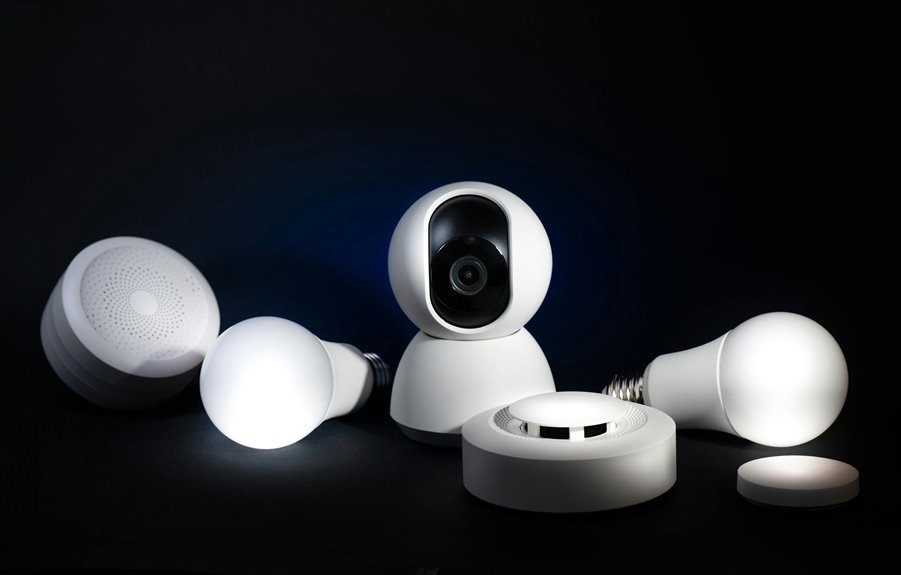To use webcams for remote equipment monitoring, start by selecting a camera that meets your resolution and field of view needs. Set it up in a way that ensures a clear, unobstructed view. Ensure you've got a stable internet connection and proper power supply to prevent interruptions. Secure your webcam with strong passwords and regular software updates. Make sure to maintain clean surroundings for optimal performance. Keep exploring for more tips on maximizing your webcam setup!
Table of Contents
Key Takeaways
- Select a high-resolution webcam (1080p minimum) with a wide field of view for effective remote monitoring of equipment.
- Position the webcam strategically to avoid obstructions and consider lighting for optimal visibility of the monitored area.
- Ensure a stable internet connection, preferably wired, to maintain uninterrupted monitoring and reduce latency.
- Regularly update webcam software to enhance performance and security, addressing any vulnerabilities promptly.
- Utilize features like motion detection for proactive monitoring and document any issues for future troubleshooting.
Selecting the Right Webcam for Your Needs
When you're looking to set up remote monitoring, selecting the right webcam is crucial. Start by considering the resolution; a higher resolution ensures clearer images, making it easier to identify details. Look for at least 1080p for optimal clarity.
Next, think about the field of view; a wider angle lets you monitor larger areas without needing multiple cameras. You'll also want to check for features like night vision and motion detection, which enhance functionality in low-light conditions.
Don't forget about connectivity options—USB webcams are easy to set up, while IP cameras offer more flexibility. Lastly, consider your budget; it's possible to find reliable options across various price ranges. Choosing wisely can make a significant difference in your monitoring experience.
Setting Up Your Webcam for Optimal Monitoring
To set up your webcam for optimal monitoring, start by choosing the right model that fits your needs.
Next, think about where you place it, as positioning can greatly affect the quality of your feed.
Don't forget to consider lighting and your environment, since these factors play a crucial role in how well your webcam performs.
Choosing the Right Webcam
Choosing the right webcam is crucial for effective remote monitoring.
First, consider the resolution; a minimum of 1080p is ideal for clear images. Look for webcams with good low-light performance, especially if your monitoring happens in dim conditions.
Check the field of view; a wider angle lets you capture more of the area you're monitoring. Ensure the webcam has a reliable frame rate; 30 frames per second is a good standard for smooth video.
Also, think about audio capabilities if you need sound. Lastly, check for compatibility with your existing software and hardware to avoid setup headaches.
Investing time in selecting the right webcam will enhance your monitoring experience and provide the clarity you need.
Optimal Placement Strategies
Although you've selected the perfect webcam, its effectiveness hinges on where you place it. Start by identifying the area you want to monitor and ensure the camera has a clear view without obstructions.
Height matters—mount your webcam at eye level for the best perspective. If you're monitoring equipment, angle it to capture essential components while minimizing blind spots.
Avoid placing it near sources of interference, like routers or appliances, which could disrupt the signal. Consider using a stable surface or wall mount for secure placement.
Lastly, test different positions before finalizing to ensure you're getting the best possible coverage. With optimal placement, your webcam will provide reliable and effective remote monitoring.
Lighting and Environment Tips
After ensuring your webcam is optimally placed, the next step is to focus on lighting and the surrounding environment. Proper lighting enhances image clarity and ensures you capture the necessary details.
Here are three tips to improve your webcam setup:
- Natural Light: Position your webcam facing a window to utilize natural light, but avoid direct sunlight that can cause glare.
- Supplemental Lighting: If natural light isn't sufficient, use soft, diffused lighting sources like lamps or ring lights to illuminate the area evenly.
- Minimize Background Clutter: Keep the area tidy and free of distractions. A clean background not only looks professional but also helps viewers focus on the equipment being monitored.
With these adjustments, your webcam will provide clear, effective monitoring.
Ensuring Reliable Connectivity and Power Supply
To ensure your webcam setup operates smoothly, focus on two critical elements: connectivity and power supply.
First, check your internet connection. A stable, high-speed connection prevents interruptions and ensures clear video feed. Consider using a wired connection if Wi-Fi proves unreliable.
Next, make sure your webcam has a consistent power source. If it's powered by USB, connect it directly to an outlet or a reliable power bank. Avoid using extension cords that may disrupt power flow.
You might also want to invest in surge protectors to safeguard against power surges.
Integrating Webcam Software for Enhanced Functionality
Integrating webcam software can significantly enhance the functionality of your remote monitoring setup.
By leveraging the right tools, you can streamline your operations and gain better insights into your equipment's performance.
Here are three key features to consider when integrating webcam software:
- Real-Time Streaming: Enable live video feeds to monitor equipment without delay, ensuring you catch issues as they occur.
- Motion Detection: Utilize software that triggers alerts when movement is detected, allowing you to respond quickly to potential problems.
- Cloud Storage: Opt for solutions that automatically save recordings to the cloud, providing easy access for later review and analysis.
With these enhancements, you'll improve your remote monitoring efficiency and maintain a closer watch on your equipment.
Implementing Security Measures for Remote Access
While remote monitoring offers great convenience, securing access to your webcam feeds is crucial to protect against unauthorized viewing and potential breaches. Start by using strong passwords and enabling two-factor authentication. Regularly update your webcam software to patch vulnerabilities. You should also limit access to only trusted individuals and use a secure VPN for remote connections.
Here's a quick overview of security measures:
| Security Measure | Description | Importance |
|---|---|---|
| Strong Passwords | Use complex combinations | Prevents unauthorized access |
| Two-Factor Authentication | Adds an extra layer of security | Enhances account protection |
| Regular Software Updates | Keeps systems secure | Fixes known vulnerabilities |
| Secure VPN Access | Encrypts your connection | Protects data during transmission |
Analyzing and Interpreting Live Feed Data
As you set up your remote monitoring system, analyzing and interpreting live feed data becomes essential for gaining valuable insights. This process empowers you to make informed decisions about your equipment's performance and health.
Here are three key aspects to focus on:
- Identify Patterns: Regularly observe the live feed to spot trends or anomalies that may indicate potential issues.
- Set Parameters: Establish baseline metrics for normal operations, allowing you to quickly detect deviations that require attention.
- Integrate Alerts: Use software that can notify you of significant changes in the feed, ensuring you stay informed without constant monitoring.
Maintenance Tips for Long-Term Use of Webcams
To keep your webcam running smoothly over time, regular cleaning and software updates are essential.
Dust and smudges can affect image quality, so make it a habit to clean the lens often.
Additionally, staying on top of software updates ensures your device operates with the latest features and security patches.
Regular Cleaning Procedures
Regular cleaning is essential for maintaining the performance and longevity of your webcam. Dust, smudges, and fingerprints can obstruct the lens, affecting image quality and clarity.
To keep your webcam in top shape, follow these simple cleaning procedures:
- Use a microfiber cloth: Gently wipe the lens and housing with a damp microfiber cloth to remove dust and smudges. Avoid abrasive materials that could scratch the surface.
- Clean the area around the webcam: Regularly dust the surrounding area to minimize particles that can settle on your webcam.
- Check and clean the cables: Inspect cables for dirt and grime. Wipe them down to prevent any interference and ensure a stable connection.
Software Updates Importance
Keeping your webcam software up to date is crucial for maintaining optimal performance and security. Regular updates often include bug fixes, performance enhancements, and security patches that protect against vulnerabilities.
Ignoring these updates can leave your system exposed to threats and may result in decreased functionality over time.
Make it a habit to check for updates monthly or enable automatic updates if available. This way, you won't miss important improvements.
Additionally, ensure that your operating system is also current, as compatibility issues can arise with outdated software.
Frequently Asked Questions
Can Webcams Be Used Outdoors for Monitoring Equipment?
Yes, you can use webcams outdoors for monitoring equipment. Just ensure they're weatherproof and have suitable lighting conditions. Position them strategically to capture the necessary angles, and you'll effectively monitor your equipment remotely.
What Resolution Is Ideal for Effective Remote Monitoring?
For effective remote monitoring, you'll want a resolution of at least 720p. Higher resolutions like 1080p or 4K provide clearer images, making it easier to spot details and ensure everything's functioning properly.
How Can I Troubleshoot Webcam Connectivity Issues?
To troubleshoot webcam connectivity issues, check your USB connection, ensure drivers are updated, and verify settings in your software. Restart both the webcam and your computer if problems persist. Don't forget to test with different USB ports.
Are There Specific Webcams Designed for Low-Light Conditions?
Yes, there are specific webcams designed for low-light conditions. Look for models featuring infrared sensors or enhanced low-light capabilities. They often provide clearer images in dim environments, ensuring you capture quality footage when needed.
Can I Use Multiple Webcams for Comprehensive Monitoring?
Yes, you can use multiple webcams for comprehensive monitoring. They allow you to cover different angles and areas, enhancing your surveillance. Just ensure your setup supports multiple feeds and that the software can manage them efficiently.




